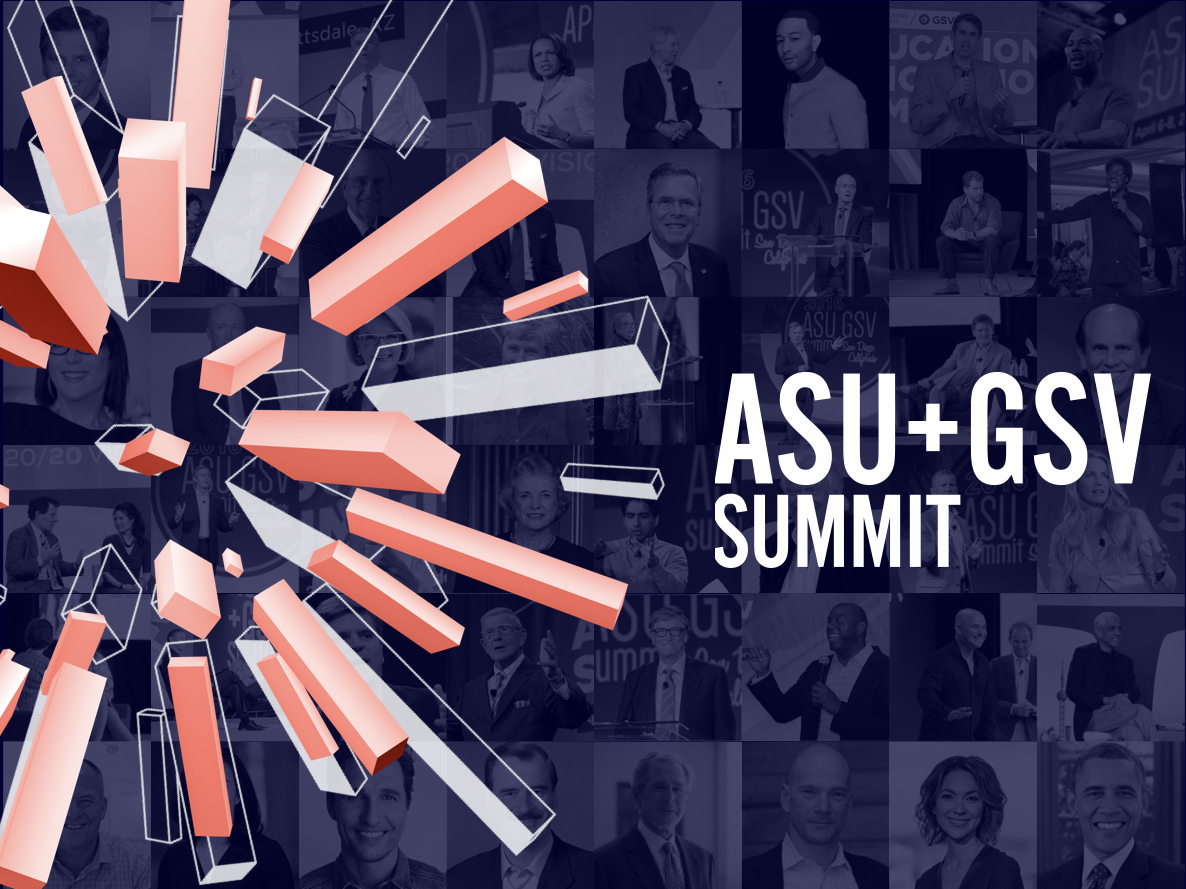Market Snapshot
| Indices | Week | YTD |
|---|
“If you think education is expensive — try ignorance.”
— DEREK BOK, FORMER PRESIDENT OF HARVARD UNIVERSITY.
“The greatest danger for most of us is not that our aim is too high and we miss it, but that it is too low and we reach it.”
— MICHELANGELO
On April 16th, leaders from across the global innovation economy will gather in San Diego for the ninth annual ASU GSV SUMMIT, with the mission of accelerating exponential ideas in education and talent. We will welcome over 4,000 entrepreneurs, educators, business leaders, policymakers, and investors, as well as over 450 game-changing presenting companies.
What makes the Summit so impactful is the unusual “cocktail” of participants we convene, with the common ingredient being a commitment to giving everybody an equal opportunity to participate in the future. Increasingly, as exponential ideas that are transforming other industries are applied to education and talent— think Tesla’s impact on the automobile industry or Airbnb upending travel and hospitality — this goal is more reachable than ever.
We all go to conferences where there are some good speakers and intellectually stimulating conversation. But when you leave, it’s over. This is why the ASU GSV Summit has so much momentum. People come because things happen here. Connections are made. Capital is raised. Ideas are brought to life. People come here to make things happen.
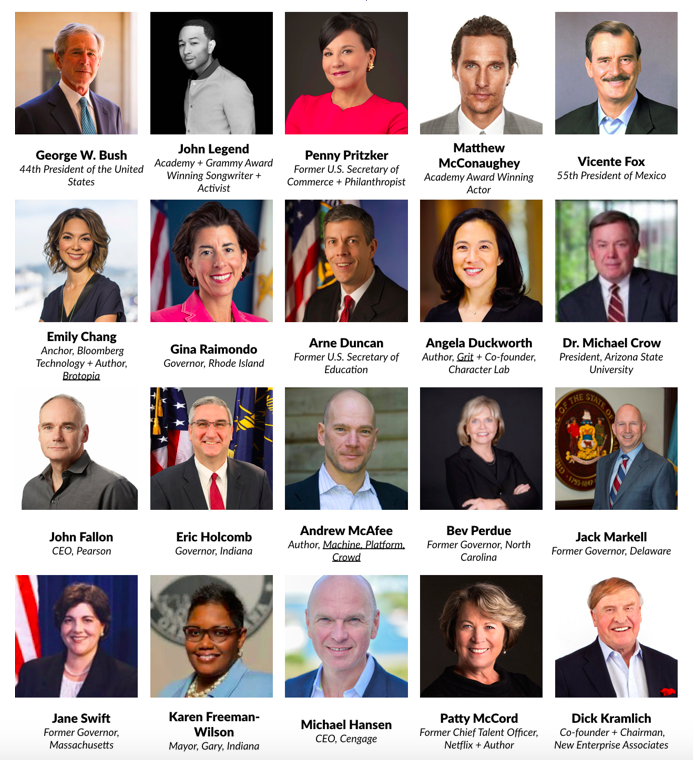
This year’s cocktail of keynote speakers includes 43rd President of the United States George W. Bush, John Legend (Academy + Grammy Award Winning Songwriter and Activist), Penny Pritzker (Former U.S. Secretary of Commerce and Philanthropist), Arne Duncan (Former U.S. Secretary of Education), Matthew McConaughey (Academy Award Winning Actor), Emily Chang (Anchor, Bloomberg Technology and Author of Brotopia), Dr. Michael Crow (President, Arizona State University), 55th President of Mexico Vicente Fox, and many others.
THE FUTURE OF THE FUTURE
Leading artificial intelligence (AI) expert Andrew Ng — the former Chief Scientist at Baidu and co-founder of Coursera — has said that, “AI is the new electricity.” What he means is that at the dawn of the 20th century, electricity transformed every major industry. It upended how the world operated, from manufacturing, to agriculture, and healthcare. (Disclosure: GSV owns shares in Coursera)
AI is poised to have a similar impact, or as Ng says, “Just as electricity transformed almost everything 100 years ago, today I actually have a hard time thinking of an industry that I don’t think AI will transform in the next several years.” E-commerce, web search, and advertising are already largely powered by artificial intelligence. AI decides if we’re approved for bank loans and it’s powering the future of autonomous vehicles. That’s just the beginning.

Source: GSV Asset Management, MIT Technology Review, Company Disclosures
Disclosure: GSV owns shares in Spotify, Lyft
There is, perhaps, no topic more overhyped than the “Future of Work”. The basic diagnosis is that technology — robots and artificial intelligence in particular — are going to eliminate all jobs as we know them. As a result, the government will have to provide the unemployable masses with a lifetime supply of food stamps and shelter.
As MIT scholars Erik Brynjolfsson and Andrew McAfee (2018 ASU GSV Summit speaker) observe in The Second Machine Age, an unsettling future is taking shape characterized by massive unemployment and economic disruption stemming from the fact that as computers get more powerful, companies will have less need for workers of any kind.
It’s undeniable that technology will replace many jobs that are commonplace today. Oxford researchers have projected that 47% of American jobs are at “high risk” of being automated in the next 20 years. McKinsey estimates that 12 million U.S. “middle skill” jobs will be eliminated by 2025. Globally, there are over 350 million manufacturing and warehouse workers — roles that are ripe to be replaced.
Aside from the minor issue that the government doesn’t make money — it takes money — one thing we know as sure as the Sun coming up in the East is that automation eats jobs. But it doesn’t eat work. In 1787, Thomas Jefferson observed that, “Agriculture is our wisest pursuit, because it will in the end contribute most to real wealth, good morals, and happiness.” We know how that played out.
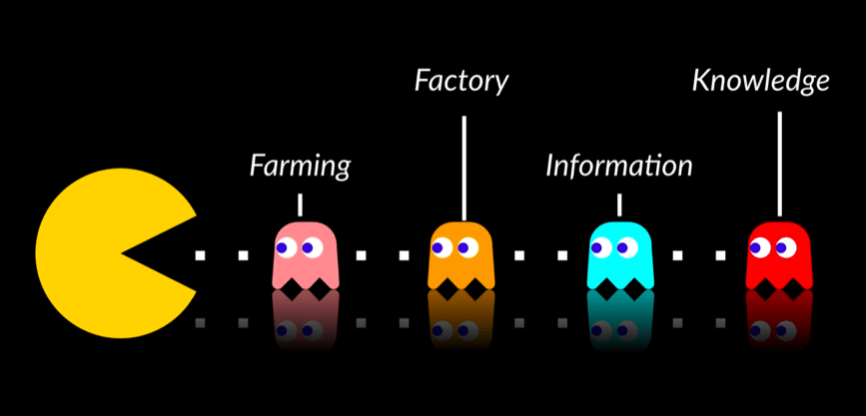
Kaizen is a Japanese business term meaning “continuous improvement.” An education corollary is GSV’s concept of “KaizenEDU,” which means “continuous learning.” In a world with smart machines, you can no longer fill up your “knowledge tank” until age 25 and cruise through life. Effective workers must refill their knowledge tanks continuously.
At this year’s ASU GSV Summit, we’re going to hear from innovators of all stripes — from entrepreneurs, to policymakers, business leaders, educators and investors — who are “thinking differently” to make KaizenEDU a reality.
That means applying transformational technologies to learning, including Big Data and Artificial Intelligence. It’s scaled platforms that are reaching millions of people with engaging and effective education opportunities — what we call “Weapons of Mass Instruction.” It’s new models that help people get the skills they need without dropping out of life and taking on massive debt.
At the 2018 ASU+GSV Summit, we’re proud to include over 10 concurrent program elements — all collectively focused on catalyzing change to ensure that everybody has equal opportunity to participate in the future.
Keynote Program
“The future started yesterday, and we’re already late.”
– JOHN LEGEND
This year, we’re especially proud to feature keynotes from two former Presidents — 43rd President of the United States George W. Bush and 55th President of Mexico Vicente Fox. Additionally, our keynote program will feature two current and three former Governors, as well as six former Secretaries or Under Secretaries of the United States.
Additionally, other prominent speakers joining our keynote stage include Academy Award winning artists John Legend and Matthew McConaughey, renowned authors Angela Duckworth, Emily Chang and Andrew McAfee, and leading education and talent business executives, including the executives from Chegg, TAL Education Group, Pearson, Cengage, Workday, Coursera, edX, Udacity and more.
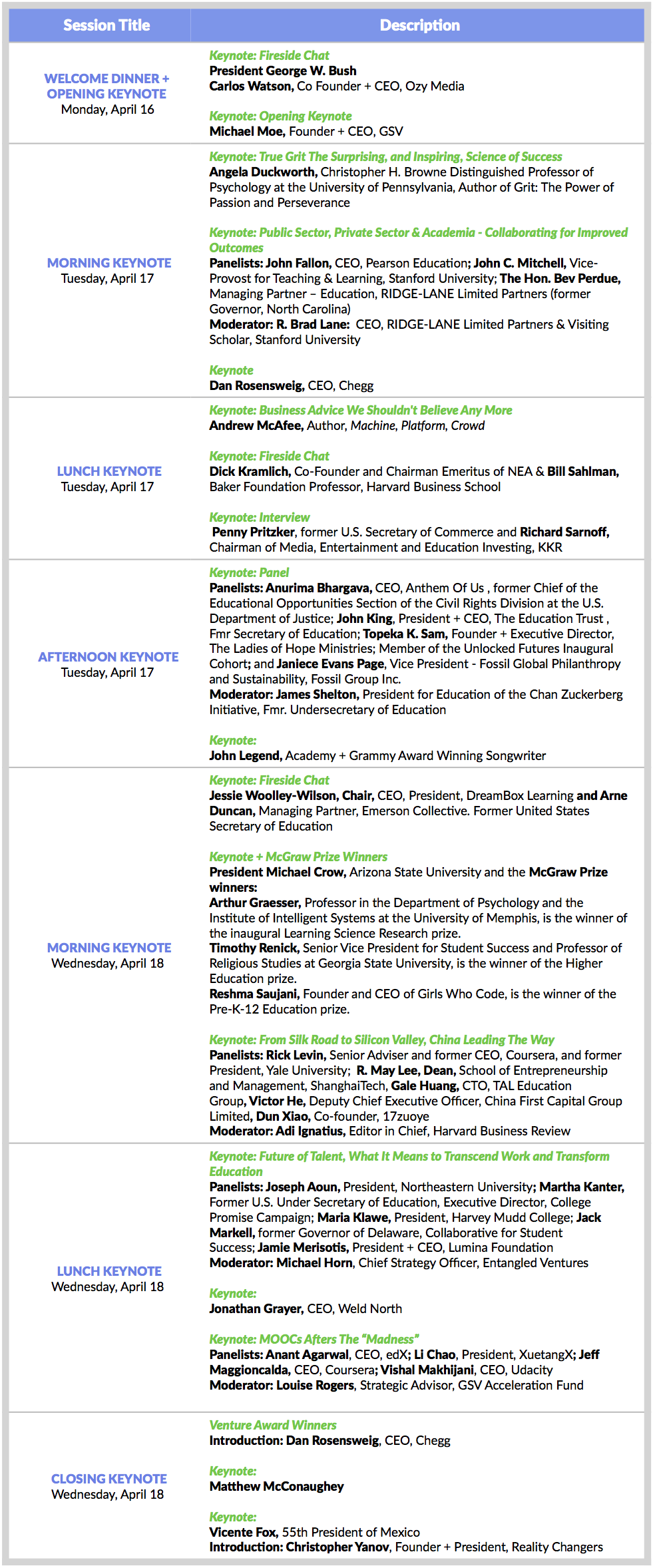
The Stars of Tomorrow — 450+ Education + Talent Presenting Companies
“Whatever the mind can conceive, and believe you can achieve”.
— NAPOLEON HILL
What do Chegg and TAL Education Group have in common? Both companies saw 141% stock growth in 2017. 2017 was a banner year for many other publicly-traded education and talent companies including, 2U (+118%), New Oriental (+94%), and Instructure (+91%), American Public Education (+96%), Adtalem Global Education (+48%), John Wiley (+24%), Franklin Covey (+60%), Rosetta Stone (+84%), Ultimate Software (+28%), and Workday (+60%).
Additionally in 2017, seven Chinese education companies went public with an average 57% return. This year, CB Insights identified “Education and Talent” as the second largest category for 2018 IPO candidates, with 20 companies in the pipeline.
In the private markets, there are seven Education and Talent unicorns, including Udacity, Udemy, Pluralsight, Glassdoor and VIPKID. Over $4 billion of venture capital was raised by learning and talent technology companies in 2017, up nearly 3x since 2012.
We’re proud to have over 450 of the World’s leading education and talent technology companies presenting at this year’s ASU GSV Summit.
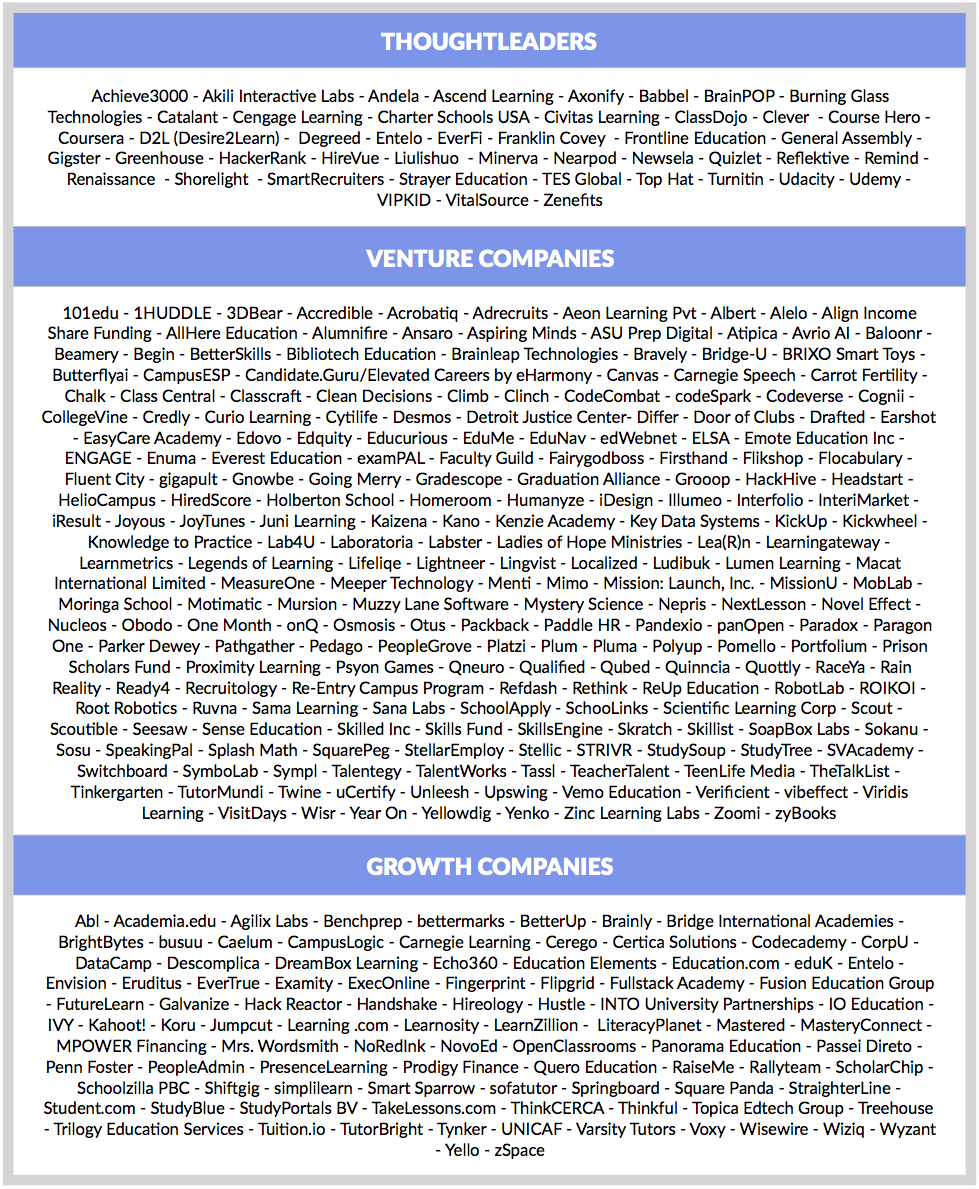
The Future of Talent
“To keep a lamp burning, we have to keep putting oil in it.”
— Mother Theresa
Throughout history, whether in pre-industrial or industrial times, great nations developed based on their access to physical resources or their ability to surmount physical barriers. England and Spain crossed oceans, Germany turned coal and iron into steel, and the United States exploited a wealth of agricultural and industrial resources to become the World’s breadbasket and industrial superpower.
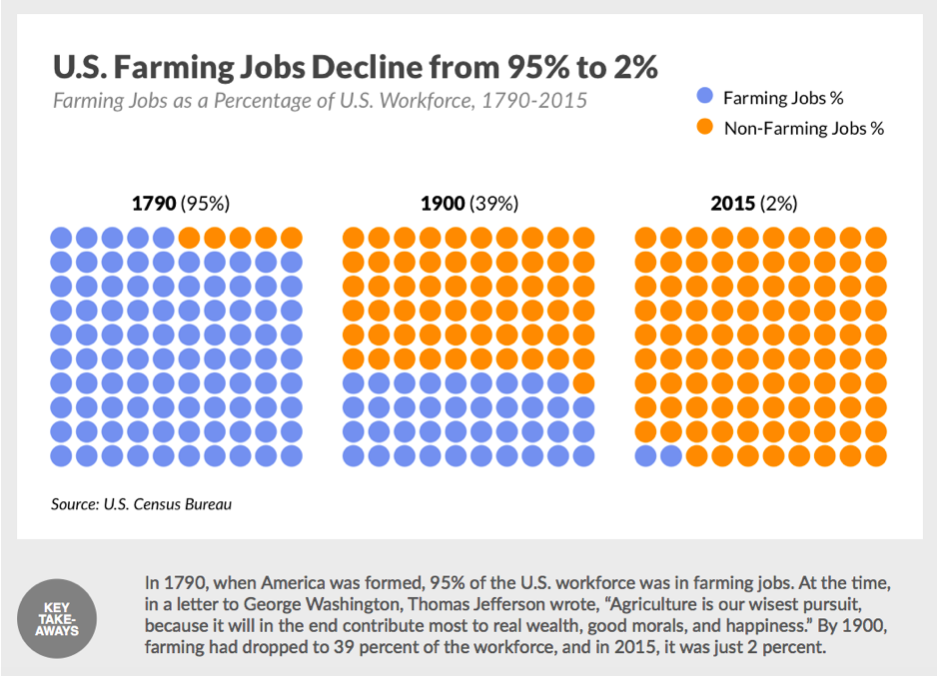
But the advent of the personal computer, the Internet, and the digital delivery of information shifted the World’s focus from physical capital to human capital. The most valuable resources in a physical economy are commodities like coal, iron, and oil. Their value is judged by metrics like purity and volume. In a knowledge economy, the most valuable resource is talent. Talent is valued based on brainpower, and the ability to acquire, deliver, and process information effectively.
At this year’s ASU GSV Summit, we’re going to hear from innovators from a variety of backgrounds who are reimagining ways to enhance and unlock talent.
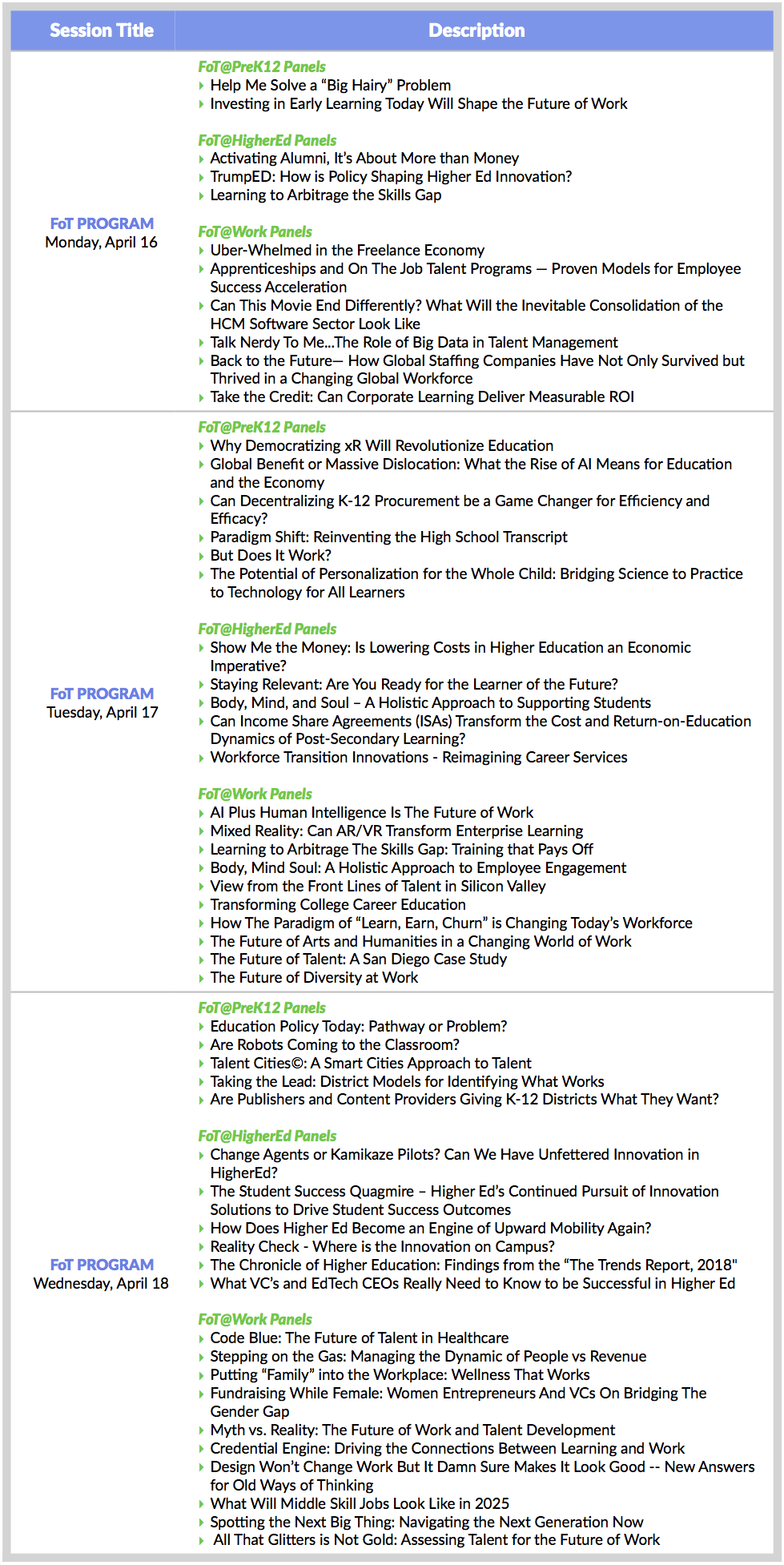
Global Silicon Valley
“The more we try to understand each other, the more exceptional each of us will be.”
— ZOOTOPIA
Looking in the rearview mirror, the economic engine for the last 100 years was the United States, Europe, Japan, and Canada. In 2000, with just 9% of the Global population, these countries contributed over 50% of Global GDP. But over the last 15 years, GDP growth has been flat-to-negative. Today the old guard contributes just 41% of Global GDP.
A key driver behind this change has been aging populations. Over 26% of these populations are over the age of 60 while just 15% are under the age of 15. In Japan last year, there were more adult diapers sold than baby diapers. These dynamics are not changing anytime soon. The average (weighted) fertility rate in Canada, the United States, Europe, and Japan is 1.6. At a fertility rate under two, you’re essentially dying.
Where is the growth and opportunity as we look ahead? One area to look is a group of countries we call the “VChIIPs” — Vietnam, China, India, Indonesia, and the Philippines.
The VChIIPs are home to over 43% of the Global population and command 28% of Global GDP, growing at 6.7%. If you look at the demographics, they are the mirror opposite of the World’s developed countries. Just 11% of the VChIIP population is older than 60, 24% is younger than 15, and the fertility rate is 2.3, driving organic growth.
But Africa is on the horizon. It claims five of the 10 fastest growing countries by population and three of the 10 fastest growing countries by GDP.

Source: International Monetary Fund, World Bank, GSV Asset Management
The ASU GSV Summit has become a global gathering of leaders focused on accelerating learning and talent. Last year, over 40 countries were represented at the Summit, with 80 senior leaders from China alone.
This year’s event will feature three days of programming on the Global Track. We are also excited to introduce ChinaWorld, which will include sessions highlighting China’s massive education and talent innovation ecosystem.
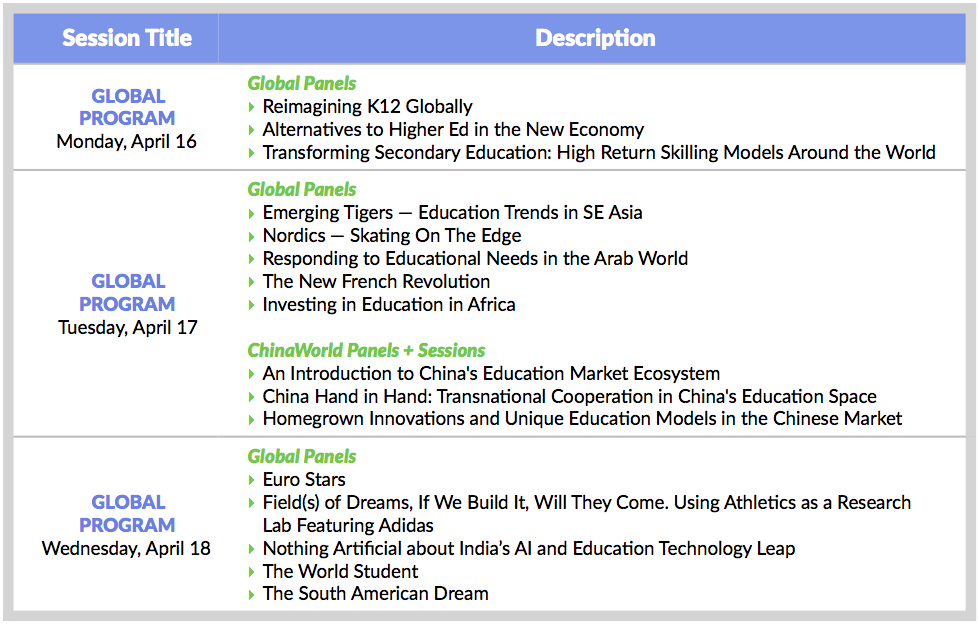
A Window to the Future
“It’s kind of fun to do the impossible.”
– Walt Disney
On a rainy, cool evening in 1954, Roger Bannister, a lanky British medical student, ran a mile in 3:59, shattering experts’ views that a sub four-minute mile was beyond human capability. The previous record of 4:01 had stood for decades, and despite advancements in training and thousands of attempts, nobody had come close to running a mile in under four minutes.
The best part of the story, however, isn’t that Bannister cracked the barrier, but that just 46 days after he did, another runner, John Landy, beat Bannister’s time. Within a few years, dozens of runners had notched sub four-minute miles. Today, the record stands at 3:43 and even high school runners have routinely beat the once impossible four-minute mark.
The distance didn’t change. The mindset did.

As the late great philosopher Muhammad Ali once said, “Impossible is not a fact. It’s an opinion.” Entrepreneurs around the world continue to defy gravity, using technology to create solutions to the World’s toughest problems.
In that spirit, this year, we are introducing GSV FutureLabs — an exhibition of the World’s most innovative technologies in education and beyond. Our objective is to create a window to the future that will drive our dialogue about education and talent today.
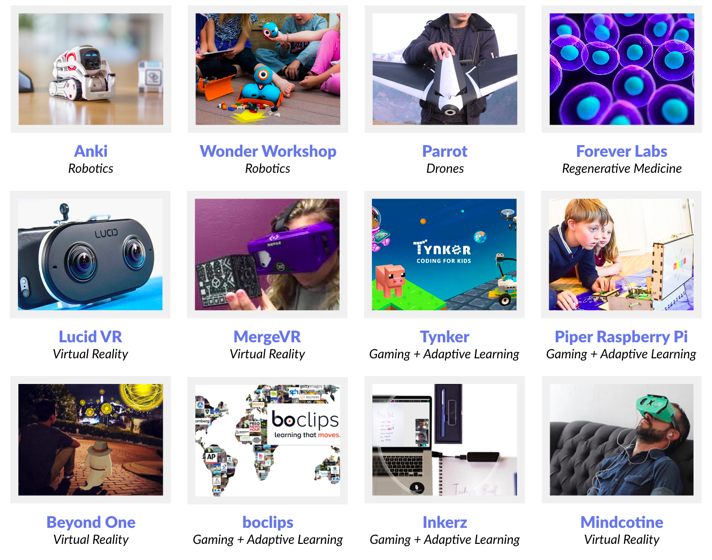
The full agenda for the 2018 ASU+GSV Summit can be accessed HERE. We hope to see you there!
